Proton- and Neutron-Induced SEU Cross-Section Modeling and Simulation: A Unified Analytical Approach
Abstract
Simple Summary
Abstract
1. Introduction
2. Methodology
2.1. A General Framework
2.2. Cross-Section Modeling: Energy Dependence from LET Dependence
2.3. Direct Ionization SEU Cross-Section Parametrization
3. Results
3.1. Nucleon-Induced SEU Cross-Sections
3.2. Proton-Induced SEU Cross-Sections
4. Discussion
- Our proposed method consistently derives the nuclear-induced SEU cross-section as a result of direct ionization by secondary particles. This allows the two failure mechanisms to be described in a unified manner within the same mathematical formalism.
- The generalized relation (10) is used instead of the Hazucha–Svensson formula, which is a special case of (10) for large values of the critical charge.
- This allows us to describe multiple-cell upsets and the SEUs at very low-energy deposits during direct ionization of low-energy protons.
- Unlike our approach, the traditional burst generation rate (BGR) method proposed by Ziegler and Lanford [33] is entirely based on the computation of nuclear effects and does not include critically important technological parameters such as a memory cell area . The BGR method is valid only when the sensitive volume is so large that energy deposition can be taken locally.
- Universality (both for neutrons and protons);
- Generality (the same approach to direct ionization and nuclear reaction-induced effects);
- Compatibility with circuit simulations (critical charge/energy, cell area, etc.);
- Compatibility with radiation simulations (GEANT4, SRIM, etc.);
- Flexibility (can be refined by numerical simulations and adapted to suit different purposes.
Author Contributions
Funding
Institutional Review Board Statement
Informed Consent Statement
Data Availability Statement
Conflicts of Interest
References
- Petersen, E.L.; Koga, R.; Shoga, M.A.; Pickel, J.C.; Price, W.E. The Single Event Revolution. IEEE Trans. Nucl. Sci. 2013, 60, 1824–1835. [Google Scholar] [CrossRef]
- Single-Event Analysis and Prediction. Available online: https://ieee-npss.org/wp-content/uploads/2021/11/1997-NSREC.pdf (accessed on 26 December 2023).
- Heidel, D.F.; Marshall, P.W.; LaBel, K.A.; Schwank, J.R.; Rodbell, K.P.; Hakey, M.C.; Berg, M.D.; Dodd, P.E.; Friendlich, M.R.; Phan, A.D.; et al. Low Energy Proton Single-Event-Upset Test Results on 65 nm SOI SRAM. IEEE Trans. Nucl. Sci. 2008, 55, 3394–3400. [Google Scholar] [CrossRef]
- Rodbell, K.P.; Heidel, D.F.; Tang, H.H.K.; Gordon, M.S.; Oldiges, P.; Murray, C.E. Low-Energy Proton-Induced Single-Event-Upsets in 65 nm Node, Silicon-on-Insulator, Latches and Memory Cells. IEEE Trans. Nucl. Sci. 2007, 54, 2474–2479. [Google Scholar] [CrossRef]
- Lüdeke, S.; Cardenás, G.D.; Hajdas, W.; Jaatinen, J.; Kettunen, H.; Poivey, C.; Rossi, M.; Tanios, B.; Vogiatzi, S.M.; Javanainen, A. Proton Direct Ionization in Sub-Micron Technologies: Test Methodologies and Modelling. IEEE Trans. Nucl. Sci. 2023, 70, 667–677. [Google Scholar] [CrossRef]
- Chen, W.; Guo, X.; Wang, C.; Zhang, F.; Qi, C.; Wang, X.; Jin, X.; Wei, Y.; Yang, S.; Song, Z. Single-Event Upsets in SRAMs with Scaling Technology Nodes Induced by Terrestrial, Nuclear Reactor, and Monoenergetic Neutrons. IEEE Trans. Nucl. Sci. 2019, 66, 856–865. [Google Scholar] [CrossRef]
- Fuketa, H.; Hashimoto, M.; Mitsuyama, Y.; Onoye, T. Neutron-Induced Soft Errors and Multiple Cell Upsets in 65-nm 10T Subthreshold SRAM. IEEE Trans. Nucl. Sci. 2011, 58, 2097–2102. [Google Scholar] [CrossRef]
- He, Y.; Lei, Z.; Zhang, Z.; Peng, C.; Li, J.; Zhang, E.; Yang, Y. Analysis of Atmospheric Neutron Radiation Effects in Automotive Electronics Systems. In Proceedings of the 2020 IEEE International Symposium on the Physical and Failure Analysis of Integrated Circuits (IPFA), Singapore, 20–23 July 2020; pp. 1–4. [Google Scholar] [CrossRef]
- Gordon, M.S.; Goldhagen, P.; Rodbell, K.; Zabel, T.; Tang, H.; Clem, J.; Bailey, P. Measurement of the flux and energy spectrum of cosmic-ray induced neutrons on the ground. IEEE Trans. Nucl. Sci. 2004, 51, 3427–3434. [Google Scholar] [CrossRef]
- Reed, R.A.; Weller, R.A.; Mendenhall, M.H.; Fleetwood, D.M.; Warren, K.M.; Sierawski, B.D.; King, M.P.; Schrimpf, R.D.; Auden, E.C. Physical Processes and Applications of the Monte Carlo Radiative Energy Deposition (MRED) Code. IEEE Trans. Nucl. Sci. 2015, 62, 1441–1461. [Google Scholar] [CrossRef]
- Sierawski, B.D.; Pellish, J.A.; Reed, R.A.; Schrimpf, R.D.; Warren, K.M.; Weller, R.A.; Mendenhall, M.H.; Black, J.D.; Tipton, A.D.; Xapsos, M.A.; et al. Impact of Low-Energy Proton Induced Upsets on Test Methods and Rate Predictions. IEEE Trans. Nucl. Sci. 2009, 56, 3085–3092. [Google Scholar] [CrossRef]
- Mo, L.-H.; Ye, B.; Liu, J.; Luo, J.; Sun, Y.-M.; Cai, C.; Li, D.-Q.; Zhao, P.-X.; He, Z. Neutron-induced single event upset simulation in Geant4 for three-dimensional die-stacked SRAM. Chin. Phys. B 2020, 30, 036103. [Google Scholar] [CrossRef]
- Dodd, P.E.; Shaneyfelt, A.; Horn, K.; Walsh, D.; Hash, G.; Hill, T.; Draper, B.; Schwank, J.; Sexton, F.; Winokur, P. SEU-sensitive volumes in bulk and SOI SRAMs from first-principles calculations and experiments. IEEE Trans. Nucl. Sci. 2001, 48, 1893–1903. [Google Scholar] [CrossRef]
- Zebrev, G.I.; Galimov, A.M. Compact Modeling and Simulation of Heavy Ion-Induced Soft Error Rate in Space Environment: Principles and Validation. IEEE Trans. Nucl. Sci. 2017, 64, 2129–2135. [Google Scholar] [CrossRef]
- Galimov, A.M.; Galimova, R.M.; Zebrev, G.I. GEANT4 simulation of nuclear interaction induced soft errors in digital nanoscale electronics: Interrelation between proton and heavy ion impacts. Nucl. Instrum. Methods Phys. Res. Sect. A 2019, 913, 65–71. [Google Scholar] [CrossRef]
- Inguimbert, C.; Duzellier, S. SEU rate calculation with GEANT4 (comparison with CREME 86). IEEE Trans. Nucl. Sci. 2004, 51, 2805–2810. [Google Scholar] [CrossRef]
- Outil de Modélisation de l’Environnement Radiatif Externe OMERE. Available online: http://www.trad.fr/OMERE-Software.html (accessed on 13 February 2024).
- O’Neill, P.M.; Badhwar, G.D.; Culpepper, W.X. Internuclear cascade-evaporation model for LET spectra of 200 MeV protons used for parts testing. IEEE Trans. Nucl. Sci. 1998, 45, 2467–2474. [Google Scholar] [CrossRef] [PubMed]
- Zebrev, G.I. Modeling neutron ionization effects on high-density CMOS circuit elements. Russ. Microelectron. 2006, 35, 185–196. [Google Scholar] [CrossRef]
- Zebrev, G.I.; Ishutin, I.O.; Useinov, R.G.; Anashin, V.S. Methodology of Soft Error Rate Computation in Modern Microelectronics. IEEE Trans. Nucl. Sci. 2010, 57, 3725–3733. [Google Scholar] [CrossRef]
- Inguimbert, C.; Duzellier, S.; Nuns, T.; Bezerra, F. Using Subthreshold Heavy Ion Upset Cross Section to Calculate Proton Sensitivity. IEEE Trans. Nucl. Sci. 2007, 54, 2394–2399. [Google Scholar] [CrossRef]
- Hiemstra, D.M.; Blackmore, E.W. LET spectra of proton energy levels from 50 to 500 MeV and their effectiveness for single event effects characterization of microelectronics. IEEE Trans. Nucl. Sci. 2003, 50, 2245–2250. [Google Scholar] [CrossRef]
- Chen, W. Irradiation Testing and Simulation of Neutron-induced Single Event Effects. In Proceedings of the 26th International Seminar on Interaction of Neutrons with Nuclei, Xi’an, China, 28 May 2018. [Google Scholar]
- Haran, A.; Barak, J.; Weissman, L.; David, D.; Keren, E. 14 MeV Neutrons SEU Cross Sections in Deep Submicron Devices Calculated Using Heavy Ion SEU Cross Sections. IEEE Trans. Nucl. Sci. 2011, 58, 848–854. [Google Scholar] [CrossRef]
- Zebrev, G.I. Single Event Concepts and Characterization. In Proceedings of the 4th International Conference on Radiation Effects of Electronic Devices, Xi’an, China, 26–29 May 2021. [Google Scholar]
- Zebrev, G.; Gorbunov, M.; Useinov, R.; Emeliyanov, V.; Ozerov, A.; Anashin, V.; Kozyukov, A.; Zemtsov, K. Statistics and methodology of multiple cell upset characterization under heavy ion irradiation. Nucl. Instrum. Methods Phys. Res. Sect. A 2015, 775, 41–45. [Google Scholar] [CrossRef]
- Hazucha, P.; Svensson, C. Impact of CMOS technology scaling on the atmospheric neutron soft error rate. IEEE Trans. Nucl. Sci. 2000, 47, 2586–2594. [Google Scholar] [CrossRef]
- Cecchetto, M. Experimental and Simulation Study of Neutron-Induced Single Event Effects in Accelerator Environment and Implications on Qualification Approach. Ph.D. Thesis, Montpellier University, Montpellier, France, 2021. Available online: https://tel.archives-ouvertes.fr/tel-03391539 (accessed on 13 February 2024).
- Lambert, D.; Desnoyers, F.; Thouvenot, D. Investigation of neutron and proton SEU cross-sections on SRAMs between a few MeV and 50 MeV. In Proceedings of the 2009 European Conference on Radiation and Its Effects on Components and Systems, Brugge, Belgium, 14–17 September 2009; pp. 148–154. [Google Scholar] [CrossRef]
- Bendel, W.L.; Petersen, E.L. Proton Upsets in Orbit. IEEE Trans. Nucl. Sci. 1983, 30, 4481–4485. [Google Scholar] [CrossRef]
- Granlund, T.; Olsson, N. A Comparative Study Between Proton and Neutron Induced SEUs in SRAMs. IEEE Trans. Nucl. Sci. 2006, 53, 1871–1875. [Google Scholar] [CrossRef]
- Coronetti, A.; Alía, R.G.; Lucsanyi, D.; Wang, J.; Saigné, F.; Javanainen, A.; Leroux, P.; Prinzie, J. Proton direct ionization upsets at tens of MeV. IEEE Trans. Nucl. Sci. 2022, 70, 314–321. [Google Scholar] [CrossRef]
- Ziegler, J.F.; Lanford, W.A. The effect of cosmic rays on computer memories. Science 1979, 206, 776–788. [Google Scholar] [CrossRef] [PubMed]
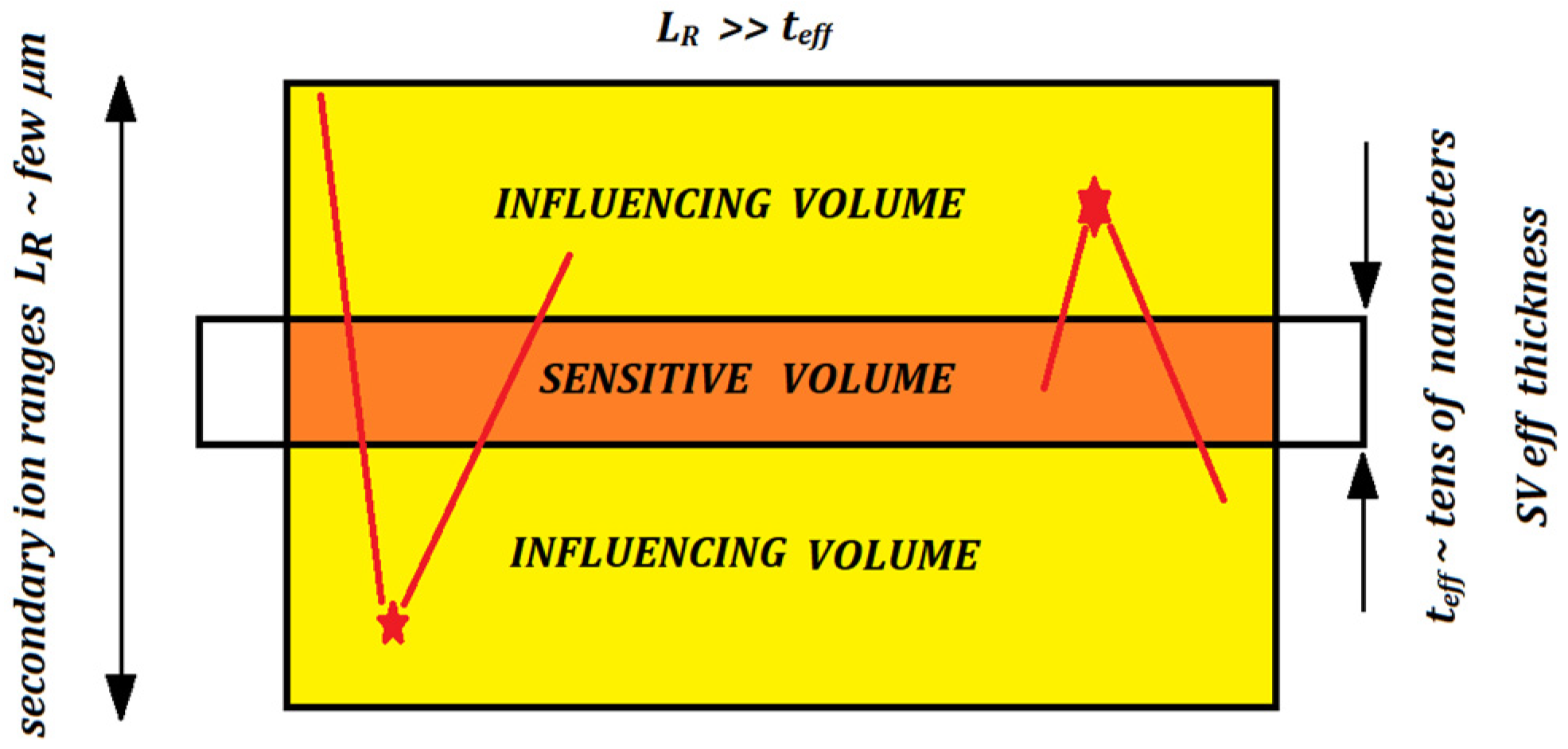
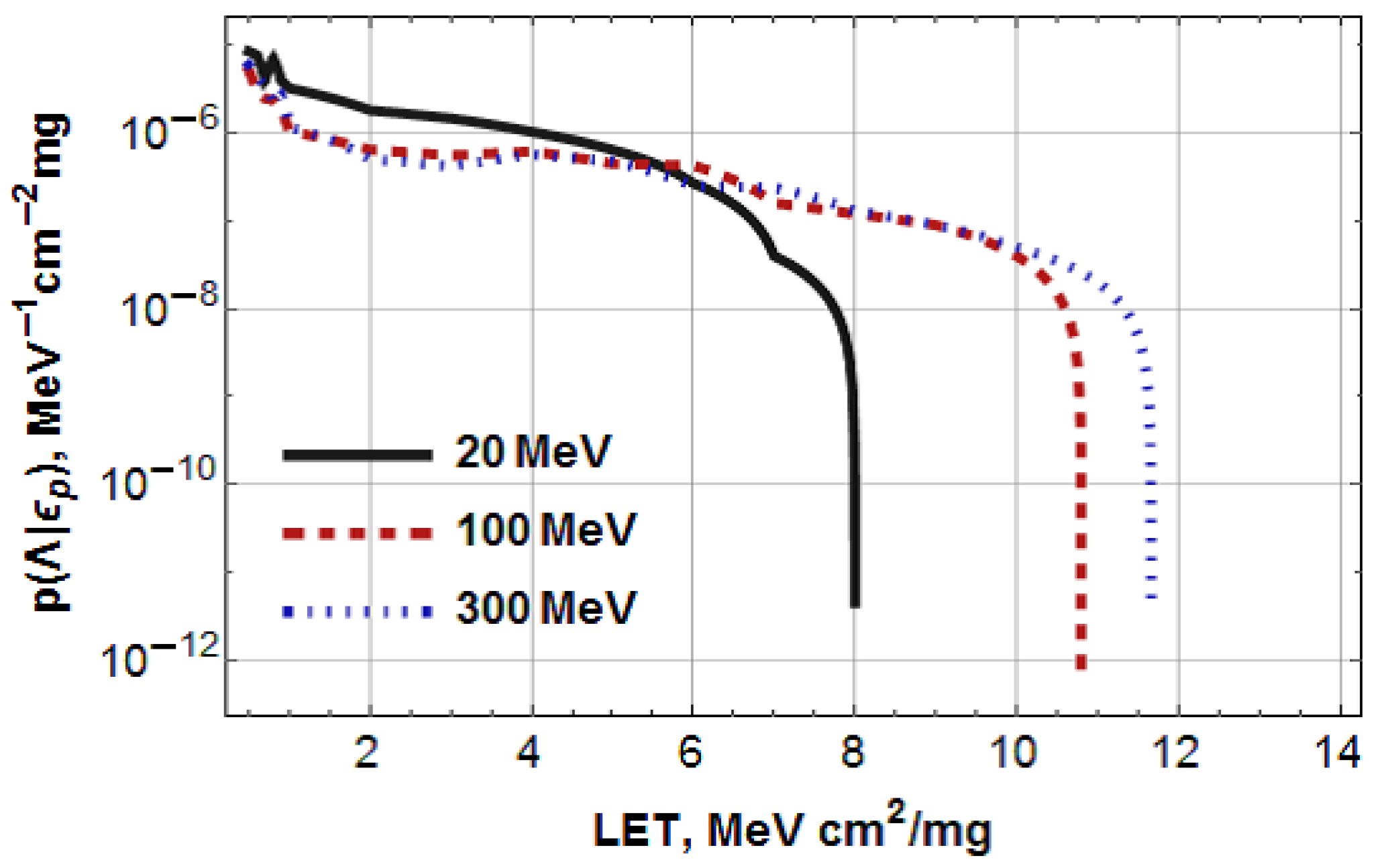
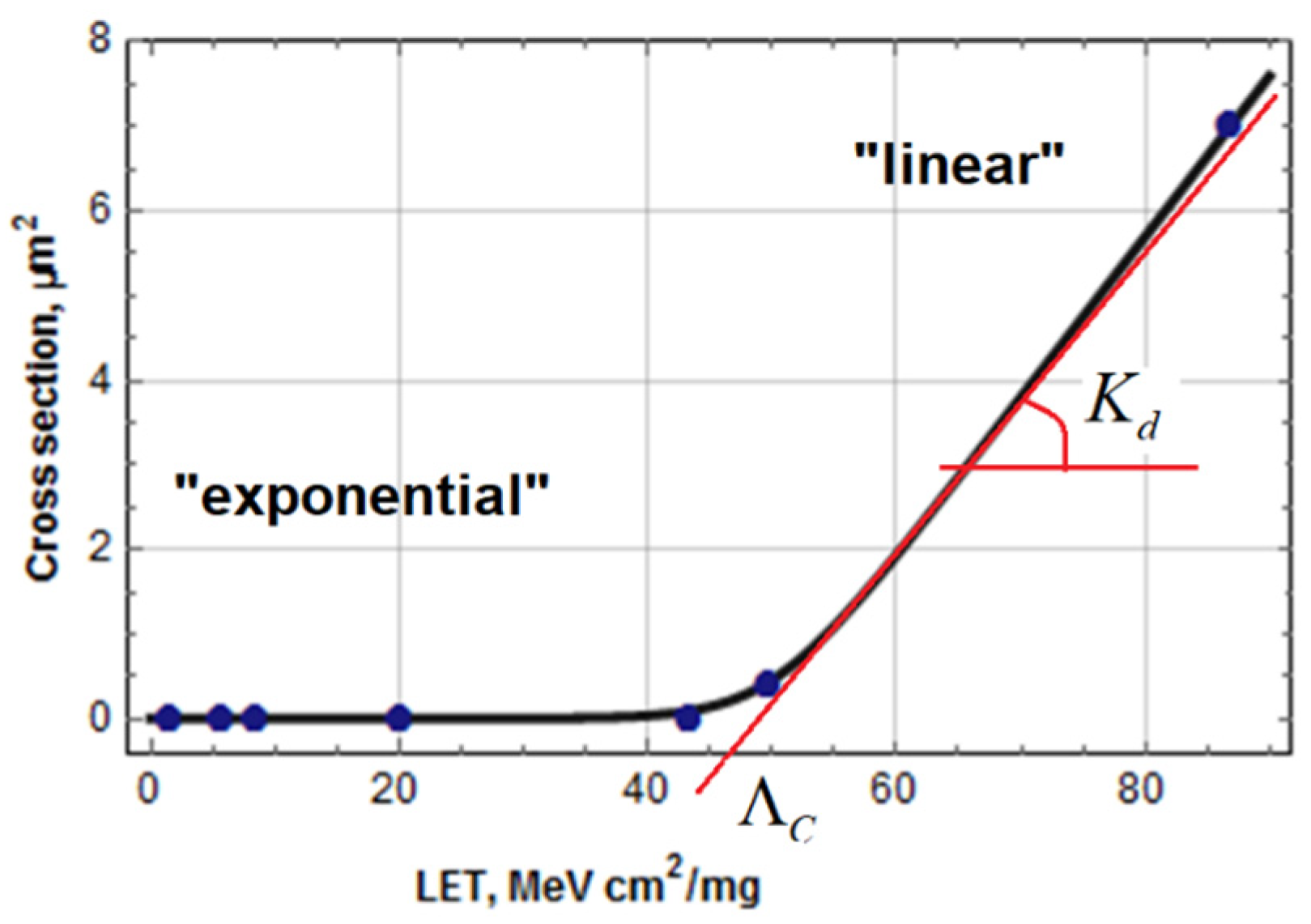
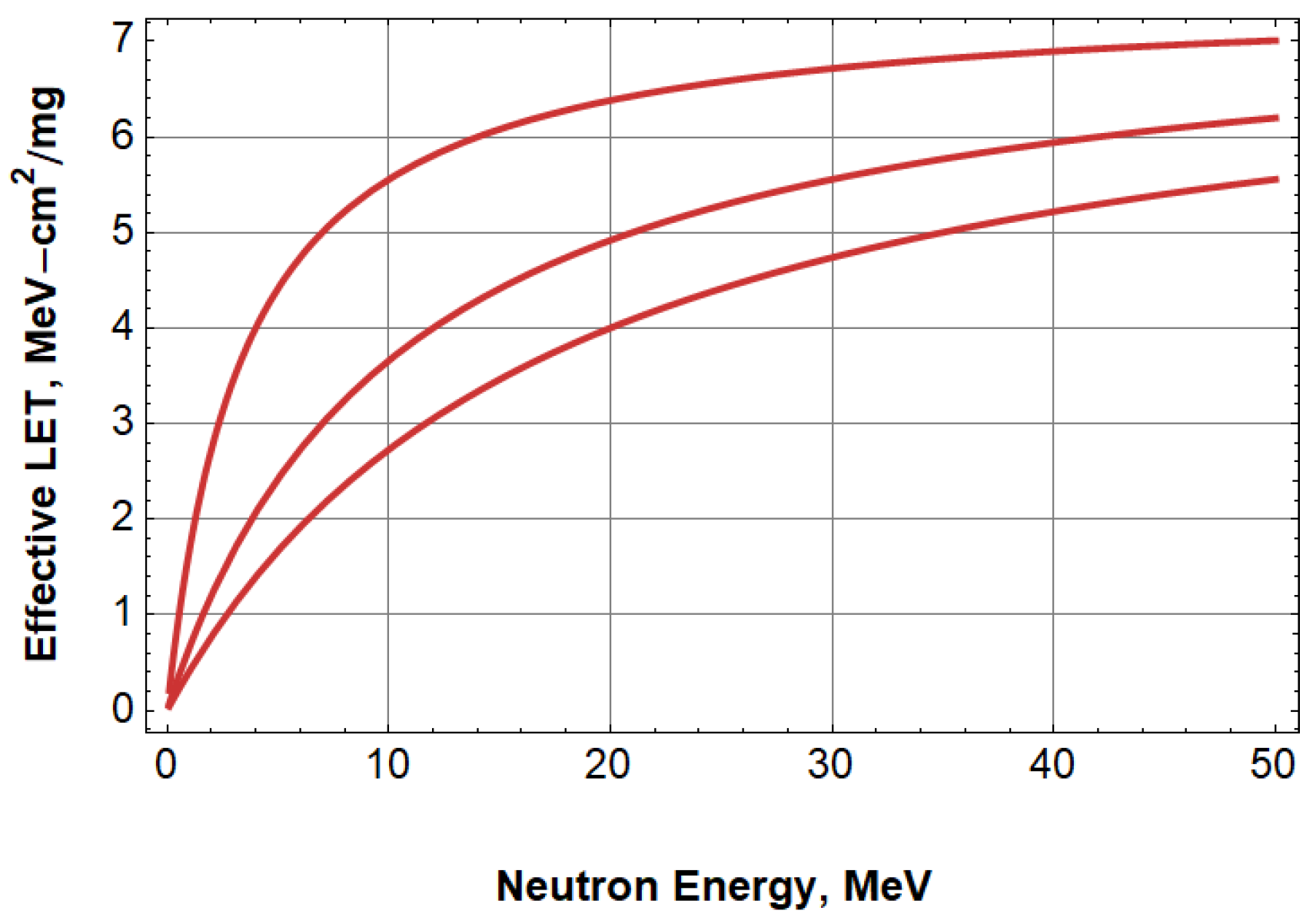
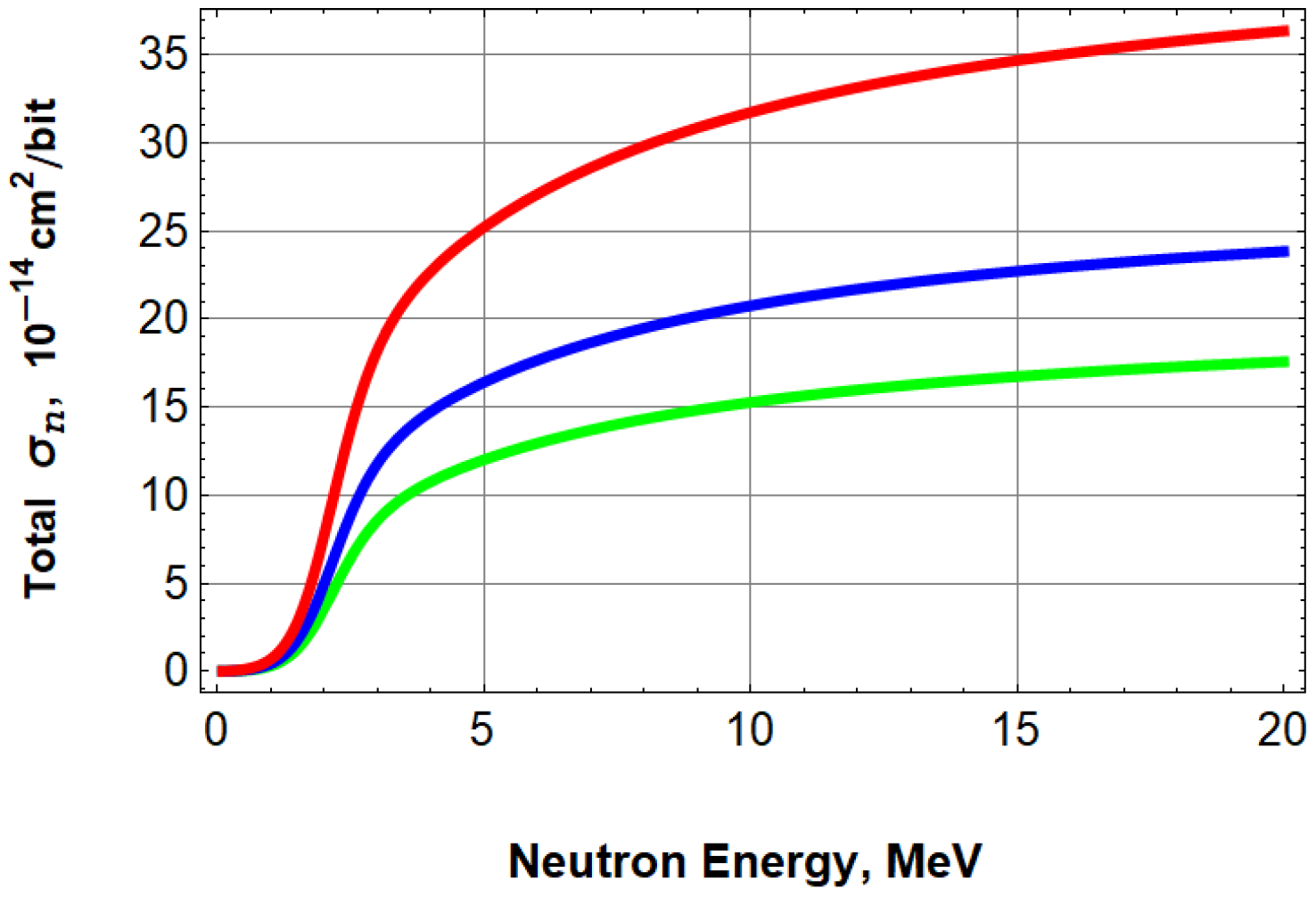
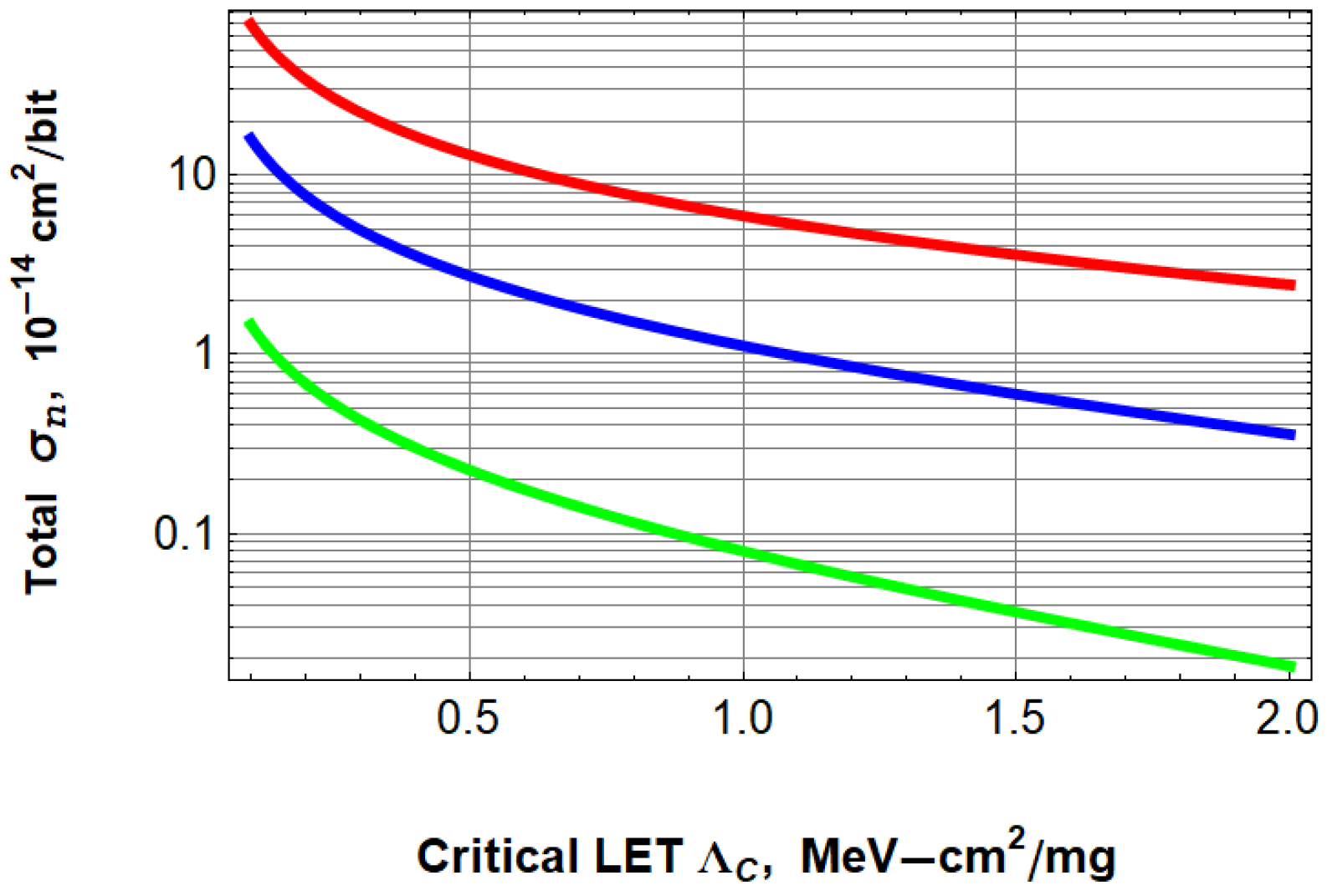
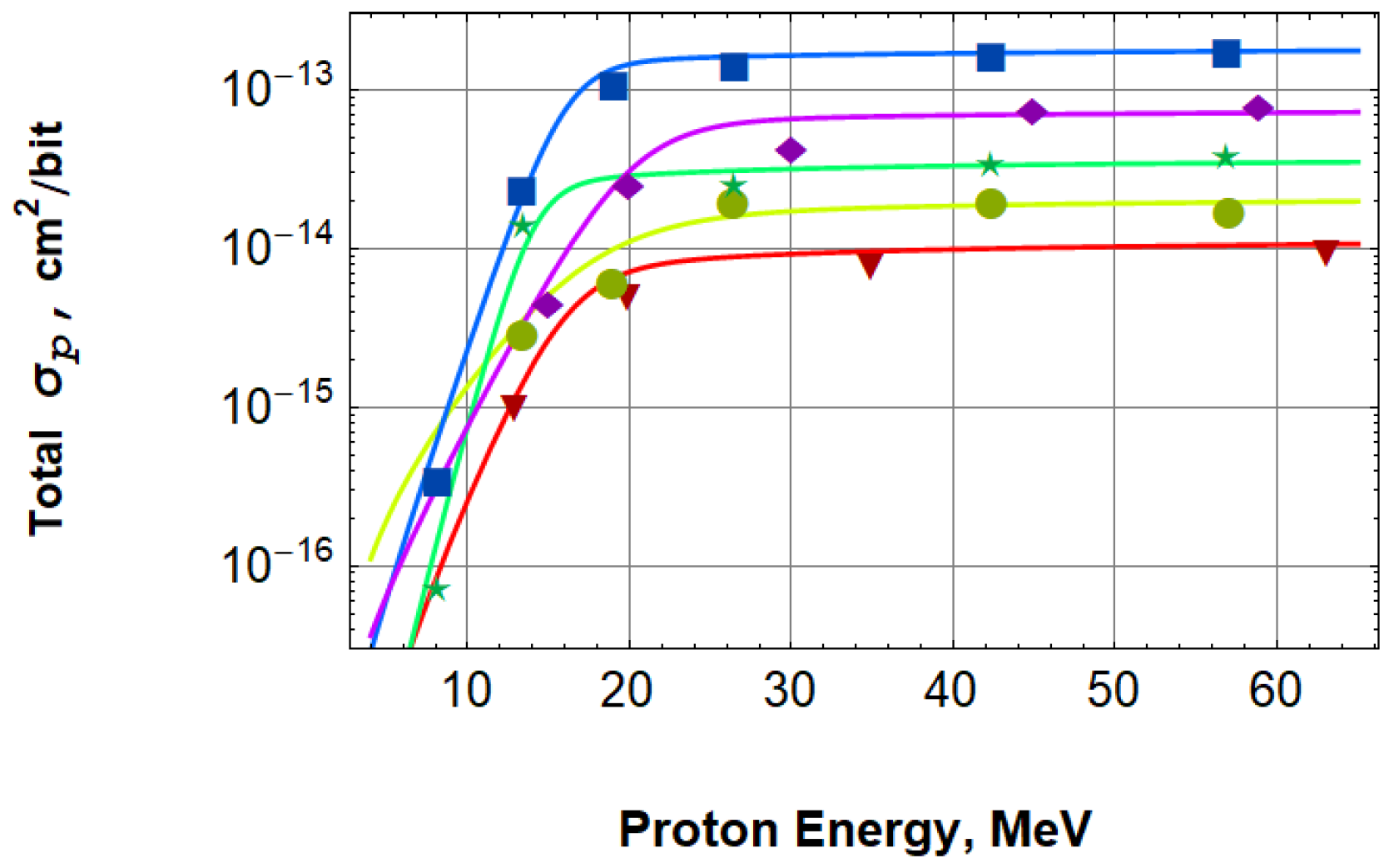

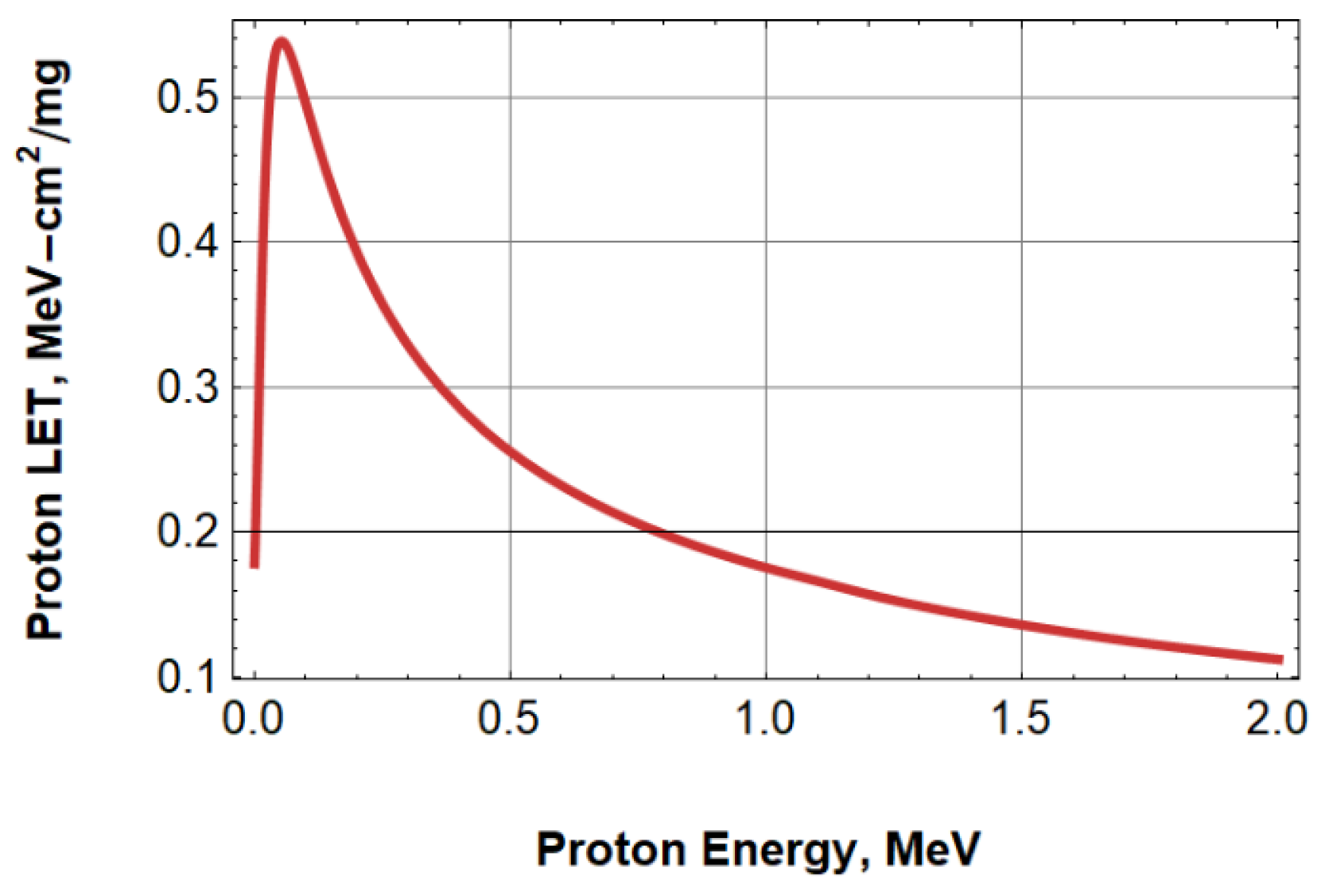
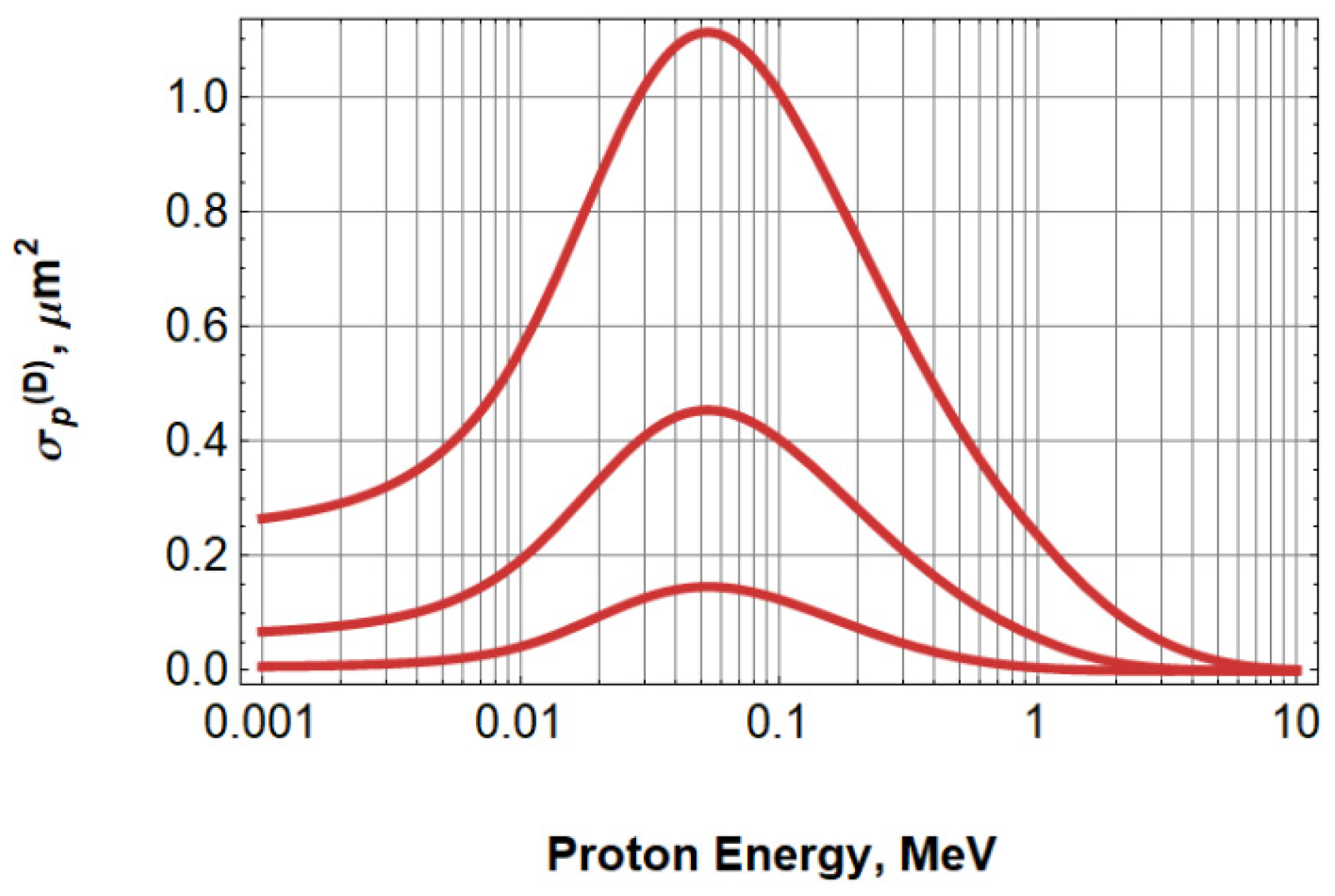
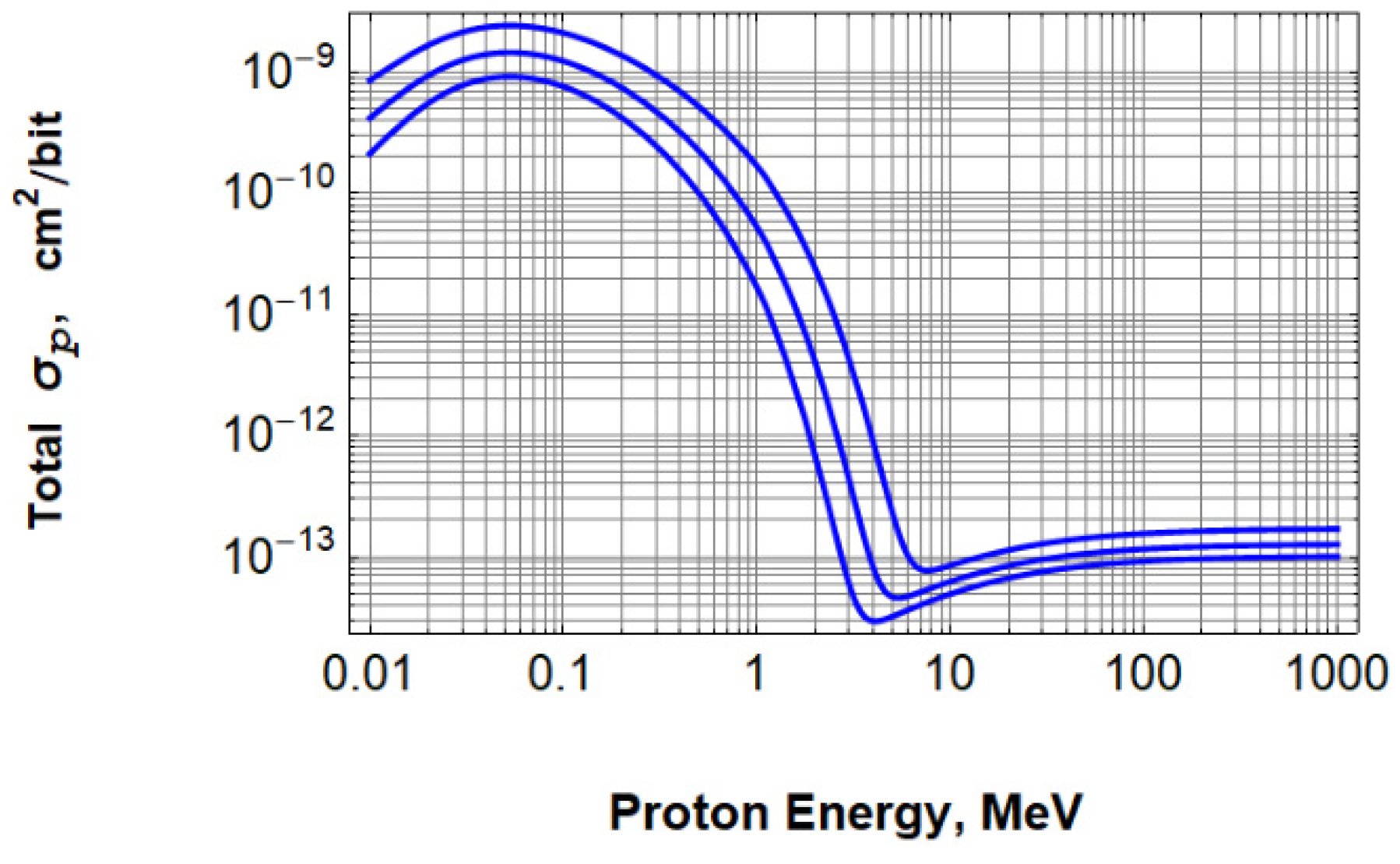

Disclaimer/Publisher’s Note: The statements, opinions and data contained in all publications are solely those of the individual author(s) and contributor(s) and not of MDPI and/or the editor(s). MDPI and/or the editor(s) disclaim responsibility for any injury to people or property resulting from any ideas, methods, instructions or products referred to in the content. |
© 2024 by the authors. Licensee MDPI, Basel, Switzerland. This article is an open access article distributed under the terms and conditions of the Creative Commons Attribution (CC BY) license (https://creativecommons.org/licenses/by/4.0/).
Share and Cite
Zebrev, G.I.; Samotaev, N.N.; Useinov, R.G.; Galimov, A.M.; Emeliyanov, V.V.; Sharapov, A.A.; Kazyakin, D.A.; Rodin, A.S. Proton- and Neutron-Induced SEU Cross-Section Modeling and Simulation: A Unified Analytical Approach. Radiation 2024, 4, 37-49. https://doi.org/10.3390/radiation4010004
Zebrev GI, Samotaev NN, Useinov RG, Galimov AM, Emeliyanov VV, Sharapov AA, Kazyakin DA, Rodin AS. Proton- and Neutron-Induced SEU Cross-Section Modeling and Simulation: A Unified Analytical Approach. Radiation. 2024; 4(1):37-49. https://doi.org/10.3390/radiation4010004
Chicago/Turabian StyleZebrev, Gennady I., Nikolay N. Samotaev, Rustem G. Useinov, Artur M. Galimov, Vladimir V. Emeliyanov, Artyom A. Sharapov, Dmitri A. Kazyakin, and Alexander S. Rodin. 2024. "Proton- and Neutron-Induced SEU Cross-Section Modeling and Simulation: A Unified Analytical Approach" Radiation 4, no. 1: 37-49. https://doi.org/10.3390/radiation4010004
APA StyleZebrev, G. I., Samotaev, N. N., Useinov, R. G., Galimov, A. M., Emeliyanov, V. V., Sharapov, A. A., Kazyakin, D. A., & Rodin, A. S. (2024). Proton- and Neutron-Induced SEU Cross-Section Modeling and Simulation: A Unified Analytical Approach. Radiation, 4(1), 37-49. https://doi.org/10.3390/radiation4010004






